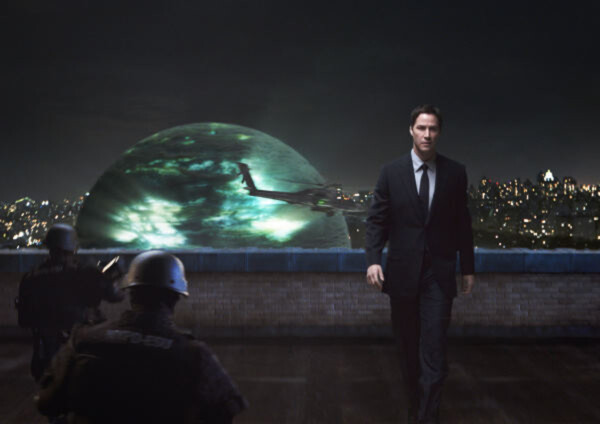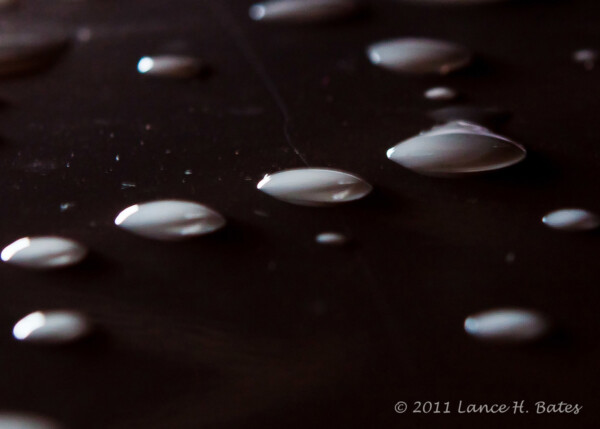Mladen and Del review ‘The Day the Earth Stood Still’

Klaatus (Keanu Reeves) arrival on Earth via a giant sphere, triggers a global upheaval.
Image courtesy of 20th Century Fox.
—
“The Day the Earth Stood Still,” starring Keanu Reeves, Jennifer Connelly, Kathy Bates, Jaden Smith, and John Cleese. Directed by Scott Derrickson, 103 minutes, rated PG-13.
Mladen’s take
Add the recently released re-make of “The Day the Earth Stood Still” to the ever-growing list of hokey films about redemption.
In fact, if you’re tired of watching Rudolph the red-nosed reindeer and his dwarf friend discover that they’re wonderful beings no matter what anyone else believes, consider “The Day the Earth Stood Still” as alternative holiday viewing fare. Here, the whole of humanity is redeemed.
There are no subtleties in this sci-fi movie.
Klaatu, the alien portrayed by Keanu Reeves, arrives aboard a cloudy, sparkling sphere. He’s an interstellar diplomat without portfolio sent by a god-like cabal of deep-space civilizations.
Klaatu’s mission is to evaluate Earth’s health. The prognosis ain’t good.
It isn’t too long before he tells astrobiologist and unwitting ally Helen Benson, played by Jennifer Connelly, that extra-galactic help would be needed to save the planet.
Benson assumes that means helping humanity but eventually figures out she’s mistaken. Klaatu had concluded that the only way to save Earth is by eradicating mankind.
The universal diplomat, protected by GORT, a very impressive gigantic automaton comprised of nano-sized wasps behaving as a single being, initiates Operation Roach Motel after explaining to Benson that, in essence, humanity is a cosmic error.
Meanwhile, what does the U.S. Defense Department do when it encounters hyper-intelligent, unbelievably technologically sophisticated entities from distant worlds? It tries to kill them, of course.
Throughout the movie, Klaatu or GORT turn military target acquisition devices, laser illuminators and high-performance aircraft against the troops using them. The aliens – masters of the electro-magnetic spectrum, severe traumatic injury repair, pure reason, and unemotive faces – gain control of the weapons systems by wireless hacking.
It takes Benson’s unceasing effort to protect her belligerent young stepson and a brief exchange of mathematical equations and a little conversation with a Nobel Prize-winning scientist for Klaatu to start recognizing that humanity ain’t all bad.
It seems – and this has never, ever, been expressed in other movies, books, poems, pamphlets, hieroglyphics or pre-Sumarian script – that humanity can become its best only after demonstrating its worst. The Nobel laureate argues that mankind has some kind of intrinsic sense that will let it know when there has been enough bloodletting and destruction of the environment, as well as the moral fortitude to correct those mistakes when the time comes.
Klaatu starts seeing the microscopic good among the overwhelming evil around him and reverses his decision to obliterate all traces of humanity. The mechanism for scraping clean the Earth’s surface is the neatest visual part of the movie. GORT dissolves into a swarm of flying nano-bots that consumes everything in its path, organic or inorganic.
The swarm is one of a few transparently biblical references in “The Day the Earth Stood Still.” Hell, at one point Klaatu even walks on water. Hallelujah.
“The Day the Earth Stood Still” is an OK movie, probably worth the price of a matinee ticket. But, I’m worried about Reeves. Come on, man, next time give me something as spectacular and revolutionary as “The Matrix.”

Del’s take
It isn’t the Earth that’s standing still – it’s Hollywood.
Talk about a movie that didn’t need remaking. “The Day the Earth Stood Still” circa 1951 is a Robert Wise classic that to this day presents a quietly dignified message about the follies of war.
“The Day the Earth Stood Still” circa 2008 is a diabetic coma-inducing fried Snickers bar of a mess, covered with sugar-dot cliches and gluey nuggets of contrived melodrama – all of it wrapped in a cloying caramel blanket of unconvincing CGI.
I’m still trying to figure out which cliché most nauseates me – the save-the-environment cliché, the racial-harmony cliché, the empowered woman cliché, the all-government-employees-are-evil cliché, the stupid-military cliché … see what I mean? One more cliche and you’d have a C-bomb big enough to do the aliens’ work for them.
Most of the characters in “The Day the Earth Stood Still” are cardboard cut-outs with Keanu Reeves winning the Oscar for Best Performance by a Stoned-Out Quualude Refugee. The lone exception is Will Smith’s kid, Jaden, who plays the rebellious and disrespectful stepson of Jennifer Connelly’s Helen Benson character (has there ever been a stepchild who liked his new mom or dad?).
Let’s not talk about logic flaws … well heck, let’s do.
Here’s the deal: The aliens have come to Earth because there are few habitable planets in the galaxy and humanity is ruining this one. To fix everything the aliens plan to unleash a biblical horde of tiny robots that will dismantle mankind molecule by molecule, restoring the earth to pristine form … presumably to serve as home base for a future alien megalopolis.
Stop and think about it – if E.T. has that kind of technology, why not unleash it on an uninhabitable world, making it habitable? Science calls the process “terraforming,” a piece of cake for Klaatu and pals.
But then there’d be no movie – albeit a stupid movie, and be $8 to the richer. And I could use that $8 to make the world a better place so we’d never again be afflicted with Keanu Reeves.
Or I could just buy beer to wash away the taste of this nasty movie.
Mladen Rudman is a former journalist and technical writer. Del Stone Jr. is a journalist and author.

Image courtesy of Flickr user Lance H. Bates under the auspices of a Creative Commons license. https://www.flickr.com/photos/7977365@N08/5709021472/
A number of people called, e-mailed, faxed, or contacted me via the Intergalactic Council to let me know what a rube I am for suggesting flying saucers are a figment of the collective unconscious.
One person even admonished me to put away my Bible (I nearly choked with laughter over that!) and asserted people like me actually hinder the exploration of space by dissing poor little E.T.
I’m not sure what to think about all this. It’s a comfort knowing that skepticism lives in this day of McDonaldized Mass Mind thinking. But at the same time, how spooky to see that this skepticism is fueled by utter nonsense.
Tell you what: I’ll eat my words if somebody can produce a real, live flying saucer, demonstrably from outer space. Until then, you guys keep shaking your hoodoo sticks and baying at the moon.
I’ll wait for the real scientists to give us our answers.
Look for their names on the silver screen! It was bad enough that I nearly sprained my back and gave myself leg cramps trying to help Harrison Ford crawl back into the airplane in “Air Force One.” But then I had to wait in agony until the end of the credits to see the acknowledgments for Eglin and Hurlburt.
But it was time well spent for about 20 of us who remained in the theater as the movie ended Sunday afternoon. When the names of our local bases rolled across the screen, everybody clapped and cheered.
“Air Force One” is one darned exciting movie – probably the best of the action-movie crop this summer. Check it out – and watch those credits roll.
Let it rain: Saturday’s deluge prompted a very strange reaction among some of us around town.
It was such a thunderous downpour – typical for Florida – that people I talked to didn’t even try to go out and about. They stayed at home and watched NASCAR, the Brickyard 400.
I’m not a big NASCAR fan, but like those other people, I was glued to the TV, rooting for all the old-timers, drivers like Bill Elliot (who is the husband of former Daily News photographer Cindy Poole) and casting hexes on young showoffs like Jeff Gordon.
Next thing you know we’ll be packing up the Winnebago and caravanning to Talladega.
Who won the race?
Somebody named Tide.
This week’s wire weirdness: DAKAR, Senegal (AP) – Vigilante mobs convinced that foreign sorcerers can shrink a man’s genitals with a mere handshake have killed eight people in Senegal in the past week.
Attackers killed five people at Ziguinghor in southern Senegal after a man accused one of them of making his penis shrink, newspapers reported Friday. At least three other people were killed in the West African nation’s capital, Dakar.
Headlines that didn’t work: Miners Refuse to Work after Death.
Strange but true: A man in Johannesburg, South Africa, shot his 49-year-old friend in the face, seriously wounding him, while the two practiced shooting beer cans off each other’s heads.
About the author:
Del Stone Jr. is a professional fiction writer. He is known primarily for his work in the contemporary dark fiction field, but has also published science fiction and contemporary fantasy. Stone’s stories, poetry and scripts have appeared in publications such as Amazing Stories, Eldritch Tales, and Bantam-Spectra’s Full Spectrum. His short fiction has been published in The Year’s Best Horror Stories XXII; Alfred Hitchcock’s Mystery Magazine; the Pocket Books anthology More Phobias; the Barnes & Noble anthologies 100 Wicked Little Witch Stories, Horrors! 365 Scary Stories, and 100 Astounding Little Alien Stories; the HWA anthology Psychos; and other short fiction venues, like Blood Muse, Live Without a Net, Zombiesque and Sex Macabre. Stone’s comic book debut was in the Clive Barker series of books, Hellraiser, published by Marvel/Epic and reprinted in The Best of Hellraiser anthology. He has also published stories in Penthouse Comix, and worked with artist Dave Dorman on many projects, including the illustrated novella “Roadkill,” a short story for the Andrew Vachss anthology Underground from Dark Horse, an ashcan titled “December” for Hero Illustrated, and several of Dorman’s Wasted Lands novellas and comics, such as Rail from Image and “The Uninvited.” Stone’s novel, Dead Heat, won the 1996 International Horror Guild’s award for best first novel and was a runner-up for the Bram Stoker Award. Stone has also been a finalist for the IHG award for short fiction, the British Fantasy Award for best novella, and a semifinalist for the Nebula and Writers of the Future awards. His stories have appeared in anthologies that have won the Bram Stoker Award and the World Fantasy Award. Two of his works were optioned for film, the novella “Black Tide” and short story “Crisis Line.”
Stone recently retired after a 41-year career in journalism. He won numerous awards for his work, and in 1986 was named Florida’s best columnist in his circulation division by the Florida Society of Newspaper Editors. In 2001 he received an honorable mention from the National Lesbian and Gay Journalists Association for his essay “When Freedom of Speech Ends” and in 2003 he was voted Best of the Best in the category of columnists by Emerald Coast Magazine. He participated in book signings and awareness campaigns, and was a guest on local television and radio programs.
As an addendum, Stone is single, kills tomatoes and morning glories with ruthless efficiency, once tied the stem of a cocktail cherry in a knot with his tongue, and carries a permanent scar on his chest after having been shot with a paintball gun. He’s in his 60s as of this writing but doesn’t look a day over 94.
Contact Del at [email protected]. He is also on Facebook, twitter, Pinterest, tumblr, TikTok, Ello and Instagram. Visit his website at delstonejr.com .